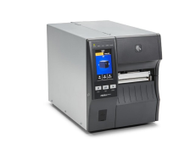What Warehouse Labels Work Best & How Do You Print Them?
24th Sep 2025
Key Highlights
-
Warehouse labels improve efficiency, accuracy, and inventory tracking.
-
Common types include barcode, location, shipping, pallet, and compliance labels.
-
Labels speed up workflows and reduce human errors.
-
Top printers in Canada include Zebra, GoDex, and Afinia models.
-
Best practices focus on durability, consistency, visibility, and scalability.
-
Strong materials like polyester and polypropylene ensure lasting performance.
-
DuraFast offers top brands, leasing options, free samples, and expert support.
Running a warehouse is complex. With thousands of items moving daily, even small labelling errors can lead to mispicks, delays, or lost inventory. These mistakes cost time, money, and customer trust, something no business can afford.
Warehouse labels solve this challenge. More than simple stickers, they guide workers to the right racks, pallets, and shelves, streamline picking, and improve inventory accuracy. A strong labelling system keeps operations smooth, safe, and efficient.
In this blog, we'll cover the most common types of warehouse labels, the best printers in Canada, and proven labelling best practices. By the end, you'll know how to set up a system that helps your warehouse run smarter and faster.
Why Warehouse Labels Matter?
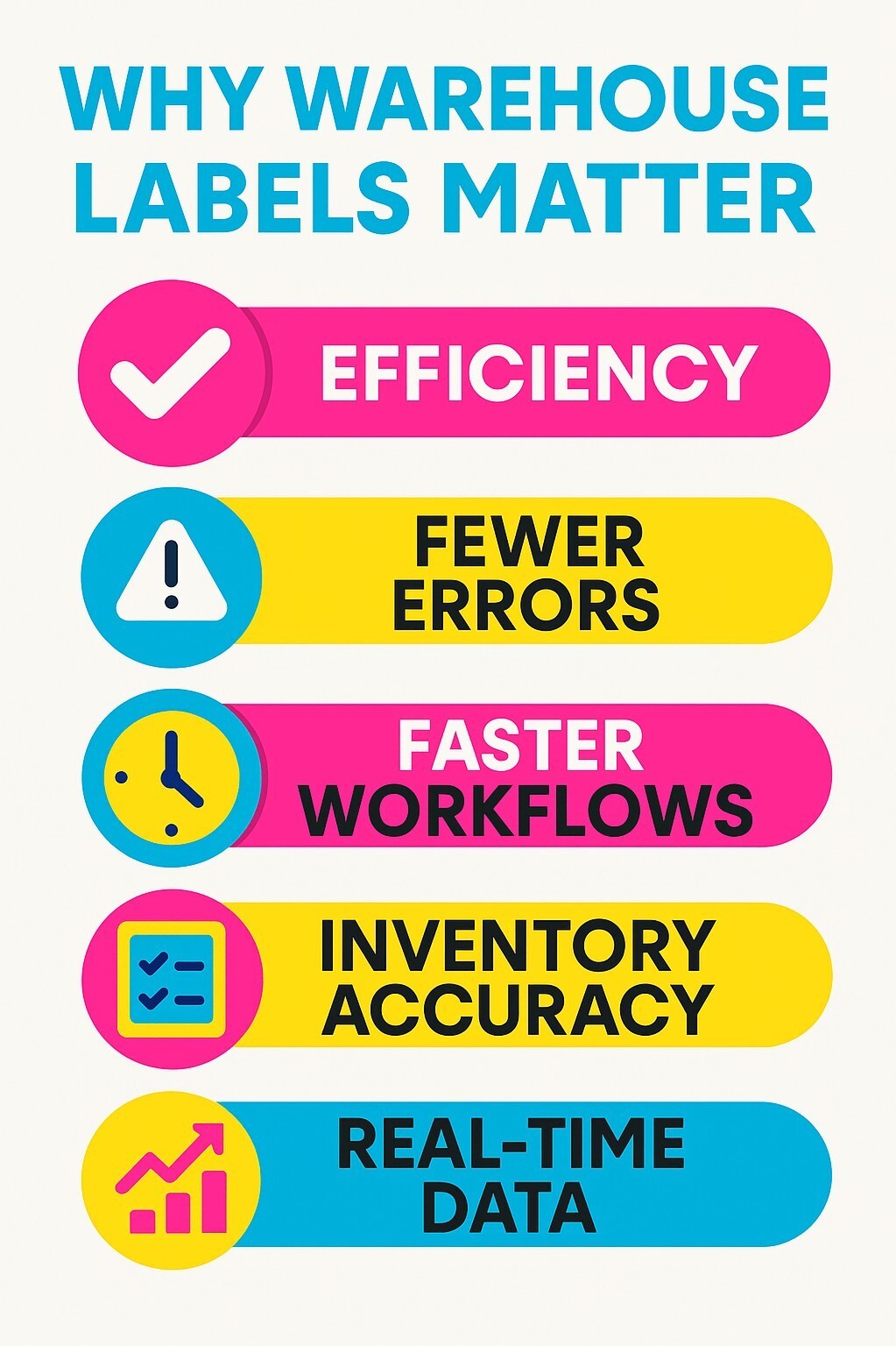
Ever wondered how large warehouses manage to keep track of thousands of items? The secret is a strong warehouse labelling system.
Labels remove the guesswork from identifying storage racks, making picking and stocking faster, easier, and more accurate.
Here’s why warehouse labels make such a difference:
-
Boost efficiency: Workers spend less time searching and more time moving products.
-
Reduce errors: Clear labels lower the risk of mispicks and misplaced stock.
-
Speed up workflows: Faster location identification leads to quicker order fulfillment.
-
Improve inventory accuracy: Durable labels on totes, trays, and pallets ensure every item is easily trackable.
-
Enable real-time data: Scanning labels gives instant updates, cutting down on manual searches.
Ready to streamline your warehouse operations? Get your custom label quote today!
Curious About Warehouse Labels? Here Are The 5 Most Common Types
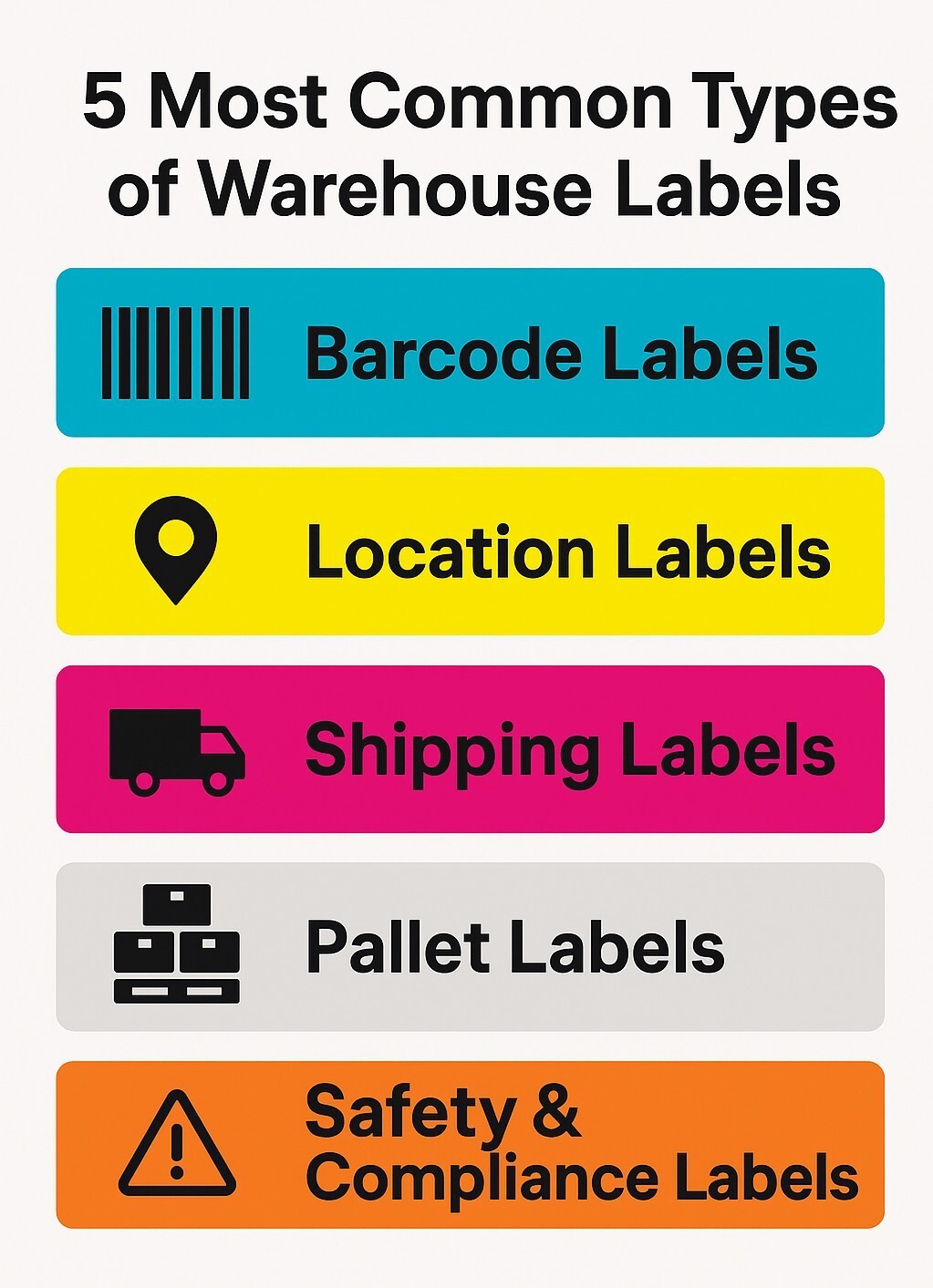
Not all warehouse labels are the same. Each type serves a specific purpose, whether it's helping workers pick faster, shipping orders correctly, or staying compliant with safety standards. Let's look at the most common types you'll see in action:
1. Barcode Labels
Think of barcode labels as the digital fingerprints of your inventory. From small screws in a parts bin to a case of beverages, a quick scan instantly updates stock levels and verifies product details. For example, a warehouse worker picking items for an e-commerce order can scan each barcode to ensure the right product is sent with no mix-ups and no wasted returns.
2. Location Labels
Ever walked down long aisles in a warehouse and wondered how workers know exactly where to go? That's the magic of warehouse location labels. They're placed on racks, bins, or shelves with unique codes (like Aisle 3, Shelf B, Bin 12). In a large grocery distribution center, location labels make sure a picker doesn't confuse peanut butter with peanut oil sitting just one rack away.
3. Shipping Labels
We've all tracked an online order before, and that's only possible because of shipping labels. These labels include the customer's address, carrier barcode, and tracking number.
For example, when a fashion retailer ships hundreds of parcels daily, shipping labels ensure each package goes to the right customer and can be traced every step of the way.
4. Pallet Labels
Pallet labels simplify handling when products are shipped or stored in bulk. Instead of scanning hundreds of boxes of bottled water, workers can scan a single pallet label to update inventory instantly.
This speeds up operations in industries like food distribution, where thousands of units move in and out of warehouses daily.
5. Safety & Compliance Labels
These are the "handle with care" voices of the warehouse. They warn of hazards, provide handling instructions, or highlight compliance requirements.
For example, a chemical storage facility will use bright hazard labels to flag flammable liquids, while a heavy machinery warehouse might use compliance labels to indicate "Team Lift Only" zones. These labels aren't just helpful, they're lifesavers.
Need a Reliable Warehouse Label Printer? Here Are 5 Worth Considering
The right printer keeps your warehouse running smoothly. From heavy-duty models to compact colour options, here are 5 of the best warehouse label printers to consider:
1. Zebra ZT411 4-Inch Industrial Thermal Label Printer 203 dpi, 14 ips, USB/Ethernet/Bluetooth ZT41142-T010000Z
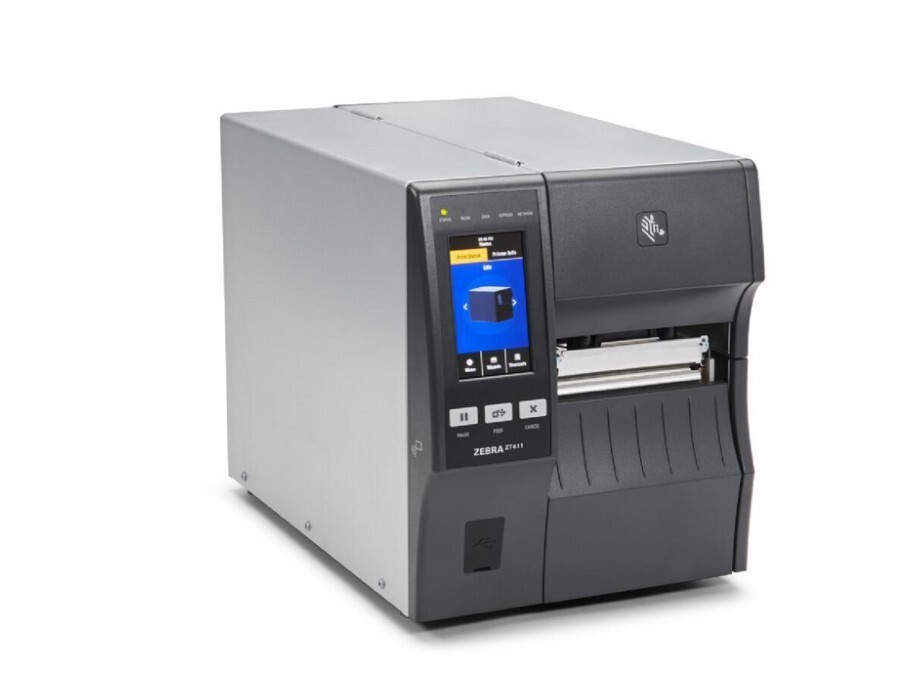
The Zebra ZT411 is a rugged 4-inch industrial thermal printer built for harsh environments. It delivers sharp 203 dpi labels at speeds up to 14 ips and ensures nonstop performance with versatile connectivity.
Why the Zebra ZT411 Stands Out:
-
Rugged design for warehouses and logistics
-
203 dpi resolution (higher dpi options available)
-
Prints up to 14 inches per second
-
Direct thermal & thermal transfer modes
-
USB, Ethernet, Bluetooth & Serial connectivity
-
Optional RFID capability
2. Afinia L801 Memjet Colour Label Printer
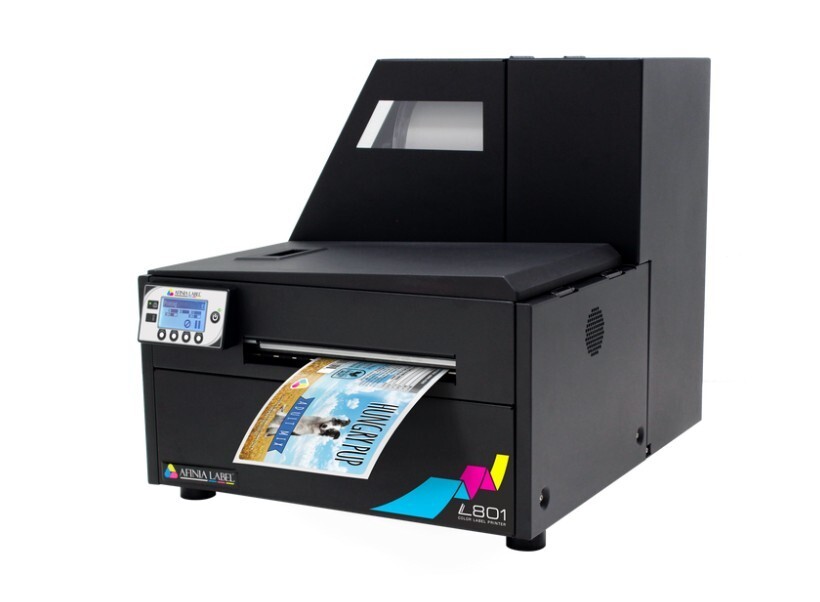
The Afinia L801 is powered by Memjet technology and designed for businesses that need professional full-colour labels at scale. It delivers vibrant, high-quality results across a wide variety of label media.
Why the Afinia L801 Stands Out:
-
Prints at speeds up to 60 feet per minute
-
Handles widths up to 8.5 inches for larger labels
-
Uses five CMYKK ink cartridges for precise, vivid colour output
-
Works seamlessly with matte, gloss, polyester, and polypropylene media
-
Built for continuous, high-volume production
-
Trusted by industries such as food, beverage, pharmaceuticals, and chemicals
The Afinia L801 combines speed, quality, and versatility, making it the perfect solution for businesses that demand standout full-colour labels in high volumes.
3. Afinia LT5C CMYK + White Label Printer
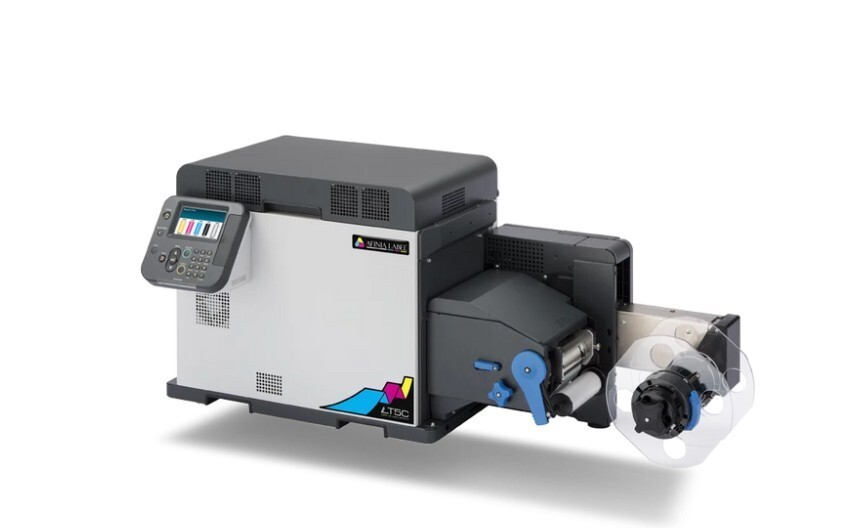
The Afinia LT5C The Afinia LT5C is a professional five-colour label printer (CMYK+White) designed for premium, durable labels. It’s ideal for specialty packaging and standout branding where vibrant, long-lasting results are essential.
Why the Afinia LT5C Stands Out:
-
Prints with CMYK plus white toner for unique effects on clear, foil, or dark materials
-
Delivers ultra-sharp 1200 x 1200 dpi resolution
-
Prints at speeds of up to 6 inches per second
-
Compatible with heat-sensitive and specialty media
-
Produces durable labels for industries like food, beverage, and cosmetics
-
Built to elevate packaging with professional-quality finishes
The Afinia LT5C is the go-to solution for businesses that want eye-catching, durable labels that make products stand out on the shelf.
4. Godex DT4L 4" 203 dpi Direct Thermal Printer, USB, RS232, LAN, Cutter Included | 011-DT4001-14L
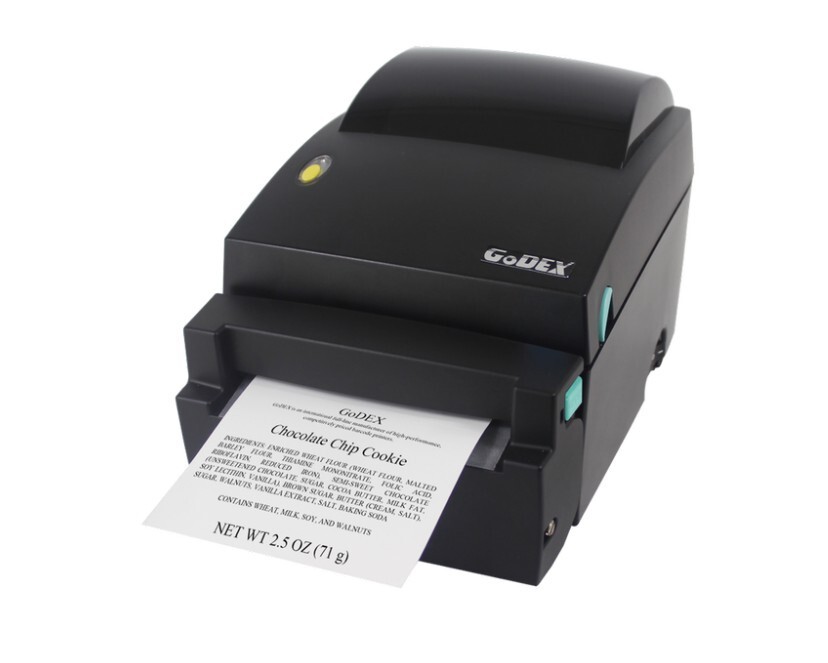
The GoDex DT4L is a 4-inch linerless direct thermal printer built for waste-free labelling. Compact yet powerful, it’s an eco-friendly choice that helps businesses reduce liner waste while maintaining high efficiency.
Why the GoDex DT4L Stands Out:
-
Prints at 203 dpi for clear, professional labels
-
Speeds of up to 7 inches per second for fast output
-
Built-in cutter for smooth, linerless operation
-
USB, RS232, and LAN connectivity for flexible integration
-
Ideal for shipping, warehouse, and logistics applications
-
Eco-friendly design that minimizes waste and reduces costs
The GoDex DT4L combines speed, sustainability, and reliability, making it an excellent choice for businesses focused on both efficiency and eco-friendly labelling.
5. Zebra ZT421 6-Inch Industrial Label Printer 203 dpi, 12 ips, USB/Ethernet/Wifi/Bluetooth ZT42162-T01A000Z
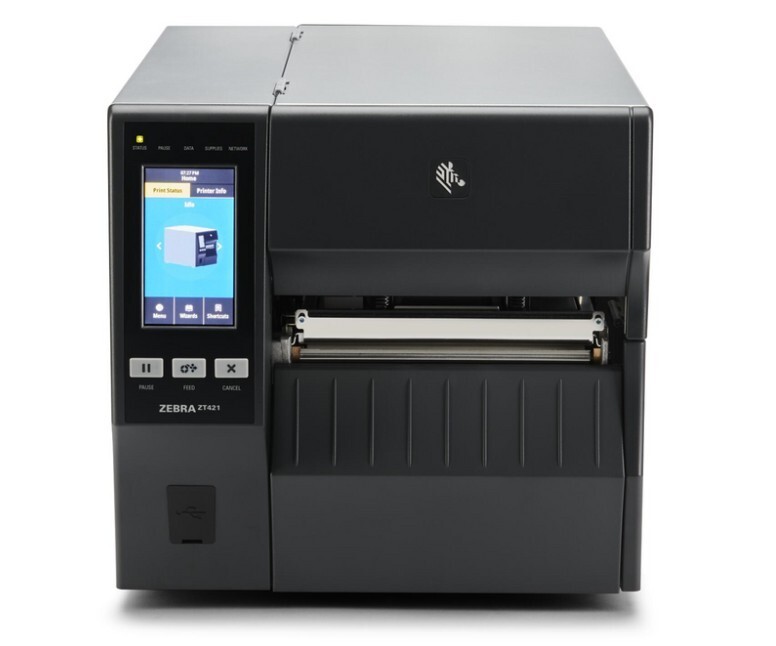
The Zebra ZT421 is a heavy-duty 6-inch industrial printer built for high-volume, wide-format labelling. Designed for demanding environments, it delivers both speed and reliability in manufacturing and warehouse operations.
Why the Zebra ZT421 Stands Out:
-
6-inch wide-format printing for large labels
-
203 dpi resolution with sharp, accurate results
-
Prints at speeds up to 12 inches per second
-
Connectivity options include USB, Ethernet, WiFi, and Bluetooth
-
Engineered for high-volume, continuous operation
-
Durable design suited for industrial environments
The Zebra ZT421 is the go-to choice for businesses that need fast, wide-format labels without compromising on durability or performance.
How Do You Master Warehouse Labelling? Here Are the Best Practices
A warehouse label is only as good as the system behind it. The right approach makes labels easy to read, scan, and trust, ensuring smooth and error-free operations. Here are some best practices to follow:
-
Choose labels that last: Warehouses aren’t gentle places. Heat, cold, dust, or heavy handling can wear labels down. Using durable materials like polyester or laminated labels ensures they survive forklifts, freezers, and daily wear.
-
Keep labels consistent: Imagine scanning one label at the top right of a rack and another hidden at the bottom left. It slows workers down. Standardizing label design, placement, and format keeps everything predictable and fast.
-
Make scanning effortless: Barcodes and QR codes cut out manual entry and update inventory instantly. For example, a picker can scan a bin label and confirm the right product in seconds instead of searching a list.
-
Label every level: Don’t just stop at warehouse racks. Pallets, totes, bins, and even shelves should be clearly labelled. That way, whether moving bulk items or single units, workers always know what they’re handling.
-
Design for visibility: Big, bold text and high-contrast colours make labels readable even from a forklift seat. A simple colour code, such as red for hazardous goods or green for ready-to-ship, can speed up decisions.
-
Stay on top of maintenance: A faded or torn label can cause as many problems as no label at all. Build routine checks into your process and replace labels before they become unreadable.
-
Plan for growth: If your warehouse expands, will your labelling system still work? Designing with scalability in mind, like using location codes that allow for new aisles and racks, saves headaches later.
Why Choose DuraFast For Label Printers In Canada?
Outsourcing label printing can be costly, slow, and prone to errors. Missed deadlines or wasted resources often hold businesses back. That’s why more Canadian companies trust DuraFast Label.ca to bring label printing in-house.
With DuraFast, you can buy or lease the right printer for your needs, from compact models for small runs to industrial systems for high-volume production.
-
Top brands like Zebra, Afinia, Toshiba, GoDEX, and NeuraLabel
-
Fast shipping across Canada with expert local support
-
Free label samples and custom label solutions
-
Flexible buy or lease options to match your budget
Ready to get started? Contact us today.
Final Thoughts
Warehouses thrive on order, speed, and accuracy, and labels are the silent drivers that make it all possible. With the right printers and a smart labelling system in place, your racks, pallets, and shipments stop being clutter and start becoming clarity.
Every well-placed label becomes a shortcut to efficiency, every scan brings you closer to a flawless order, and every durable tag is an investment in fewer errors and smoother workflows.
The future of your warehouse is not just about moving products; it is about moving smarter. Are you ready to let your labels lead the way?
Frequently Asked Questions
What are the most common types of warehouse labels?
The most common types include rack labels, shelf labels, floor labels, pallet labels, and safety or compliance labels. Each serves a unique role in organizing storage locations, improving scanning accuracy, and keeping warehouse operations efficient.
Can I use regular office printers for warehouse labels?
Regular office printers aren’t built for warehouse demands. They lack durability, speed, and media support for heavy-duty or linerless labels. Dedicated thermal or industrial printers ensure reliability, longer-lasting labels, and efficiency in fast-paced warehouse environments.
Which label printers are best for warehouses in Canada?
Some of the best warehouse label printers in Canada include Zebra ZT411, Zebra ZT421, GoDex DT4L, Epson CW-C6000, and Afinia L801. These offer speed, durability, and connectivity, making them ideal for logistics and warehouse operations.
What materials should warehouse labels be printed on?
Warehouse labels should be printed on durable materials such as polyester, polypropylene, or laminated stocks. These resist moisture, heat, cold, and abrasion, ensuring labels remain scannable and intact in demanding environments like freezers, warehouses, and shipping docks.
How do mobile printers help with warehouse labelling?
Mobile printers allow staff to print labels directly at the point of use, whether at racks, pallets, or shipping areas. This reduces unnecessary walking, speeds up workflows, and improves efficiency in picking, packing, and inventory tasks.
What are the steps to implementing a warehouse labelling system?
Start by mapping your warehouse layout, then assign logical location codes. Choose durable label materials, standardize formats, and apply labels consistently on racks, bins, and pallets. Finally, integrate with inventory software and train staff for smooth adoption.
What's the difference between magnetic warehouse labels and adhesive labels?
Magnetic labels are reusable and can be easily moved or repositioned, making them ideal for dynamic storage layouts. Adhesive labels provide a permanent solution, offering stronger durability for long-term use in fixed warehouse locations.
What information should be included on a typical warehouse label?
A standard warehouse label usually includes a barcode or QR code, location code, product SKU, and sometimes text descriptions or handling instructions. Clear, scannable information ensures faster picking, accurate inventory tracking, and fewer human errors.
Are there warehouse labelling solutions designed for e-commerce logistics?
Yes, many warehouse labelling solutions are tailored for e-commerce. These include linerless shipping labels, mobile printers for on-demand picking, and barcode systems that integrate with e-commerce platforms like Amazon, Shopify, or WooCommerce for seamless order fulfillment.
